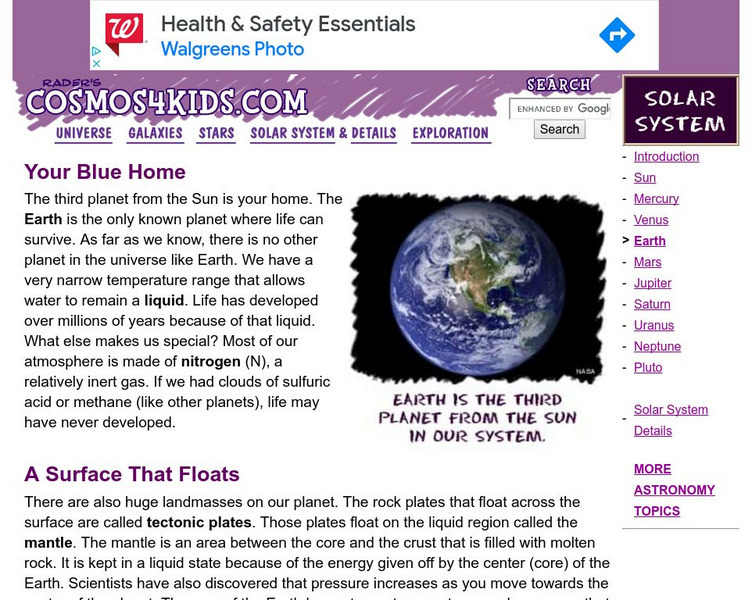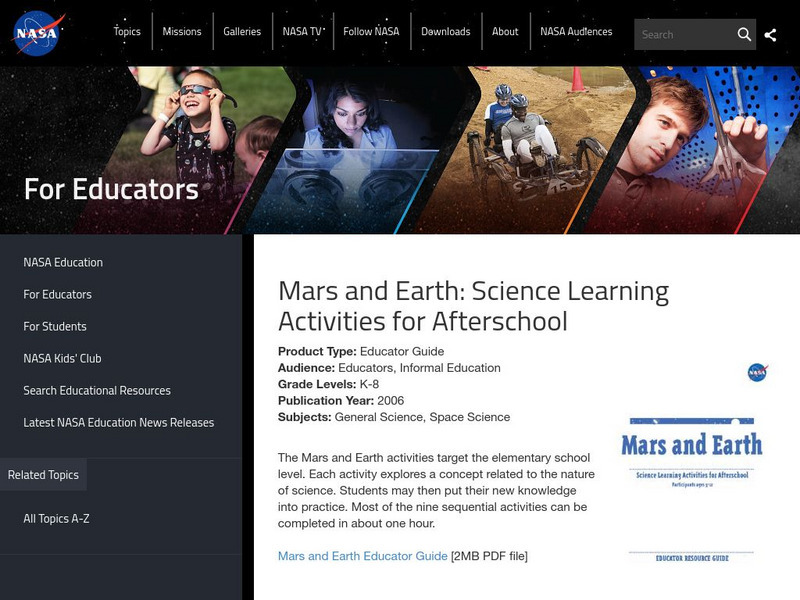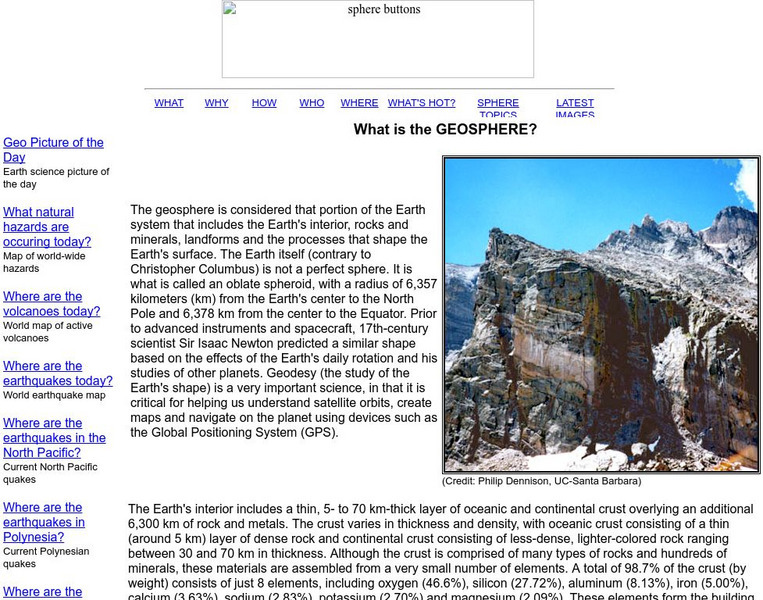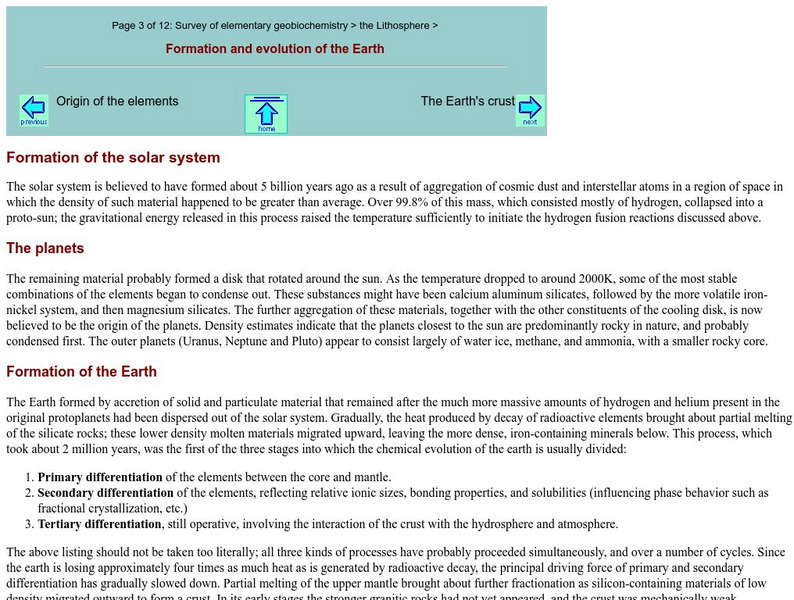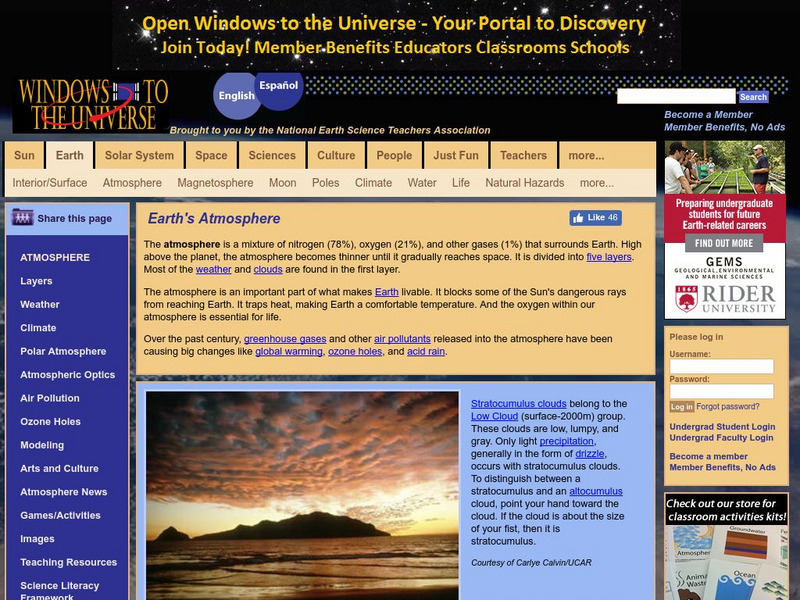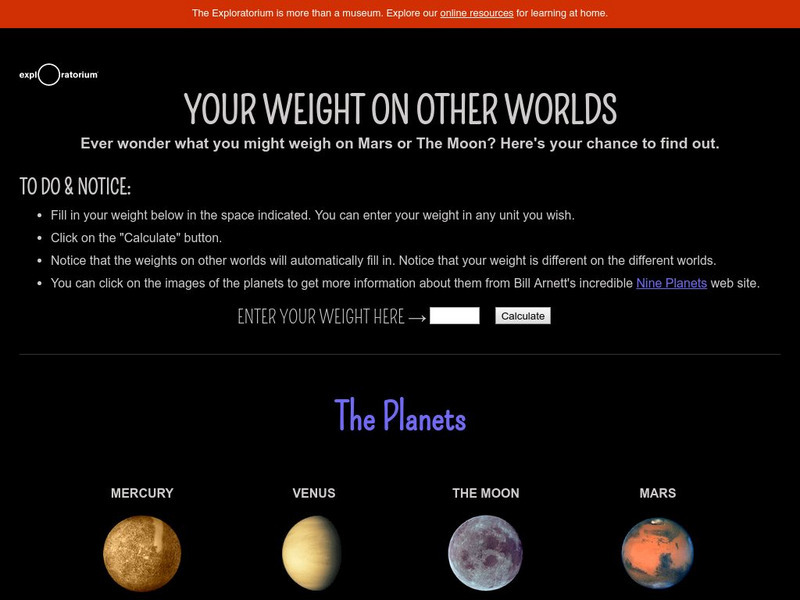Hi, what do you want to do?
Planet Pals
Planet Pals: Earth Day
This PlanetPals.com site provides the "Greatest Earth Day Pages Ever!" Includes activities, teaching aides, earth science and history, and more.
Cosmos 4 kids
Cosmos4 Kids: Solar System: Earth
Learn the basic facts about planet Earth, and its unique position as the only known planet where life can survive. The brief, to the point text makes this site most suitable for younger researchers.
Fourmilab Switzerland
John Walker: Earth and Moon Viewer and Solar System Explorer
This website provides numerous images of the Earth and moon, shown from various vantage points.
NASA
Nasa: Mars and Earth: Science Learning Activities for Afterschool
This set of activities teaches students about the big picture of science using Mars as an example: how to collect data, use evidence, and look at models.
Rice University
Museums Teaching Planet Earth: What Is the Geosphere?
Describes Earth's layers, which make up the geosphere.
California Institute of Technology
Spitzer Science Center: Historias Desde Espacio: Premiacion a Las Planetas
All the planets are competing to see who is the best planet in the Solar System. Read the story in Spanish to learn the results of the pageant. Excellent source of information presented in a fun manner.
Simon Fraser University
Chem1 Virtual Textbook: Formation and Evolution of the Earth
As part of the General Chemistry Virtual Textbook, this site examines a variety of topics related to the Earth. Topics covered in the discussion include formation of the solar system, the planets, the continents, primary differentiation...
NASA
Planetary Geodynamics Laboratory: Ocean Tides and the Earth's Rotation
An explanation of the effect that the tides have on the Earth's rotation.
National Earth Science Teachers Association
Windows to the Universe: The Earth's Atmosphere
Windows to the Universe offers information on the Earth's atmosphere. The site contains links to a weather crossword puzzle and images.
Science Education Resource Center at Carleton College
Serc: Creating Custom Map Images of Earth and Other Worlds
Become familiar with Jules Verne Voyager, a freely-available online map tool that includes data for Earth as well as several other planets and moons. Create a variety of map images and then save and import the images into a presentation...
NASA
Nasa: Our Restless Planet
This animation library is a great resource for a diverse list of earth science topics including: tsunamis, land subsidence, magnetic fields, volcanoes earthquakes, floods, and sea level changes.
Exploratorium
Exploratorium: Your Weight on Other Worlds
From the Exploratorium Museum. Includes an interactive feature in which a visitor enters their weight on earth and has their weight on other planets computed and displayed. Discusses the distinction between mass and weight and describes...
NASA
Nasa Star Child: The Planet Earth
Facts about the Earth including its orbit, its atmosphere, and its landforms. Includes a discussion question on seasons, with facts about them, and the answer. A linked page covers similar material in a "Level 2" version, and has a...
Other
Reach the World: Geogames Build Planet Earth
Practice your mapping skills with Build Planet Earth! This animated 3D globe challenges players to locate the Poles, continents, countries, and cities. Colorful graphics and sound effects as well as a teacher's lesson plan are included.
PBS
Pbs News Hour Extra: Newly Discovered 'Goldilocks' Planet Has Potential for Life
Probably one of the coolest things to imagine is life on another planet! What would it look like? What could it possibly be? Scientists have discovered a planet much like Earth. "I would say that the chances for life on this planet are...
NASA
Nasa Star Child: Earth the Water Planet
Use this site to read about planet Earth. See a photo of the Earth from space, and learn quick facts about the earth's atmosphere, axis, and surface.
NASA
Nasa Star Child: The Planet Mercury
Basic facts about the planet Mercury including its size, its name, and its atmosphere. Includes a discussion question on its visibility from Earth, with facts, and the answer. A linked page covers similar material in a "Level 2" version,...
PBS
Pbs News Hour Extra: Lesson Plan: Planets in Proportion
Students learn about the distance and relative size of the rest of the planets compared to the Earth and Sun. The lesson plan includes an assessment and extension activities.
PBS
Greenhouse Green Planet
Why is the earth just the right temperature to support life? The answer is the greenhouse effect, and you can learn more about it using this resource.
US Environmental Protection Agency
Epa: Causes of Climate Change
Earth's temperature depends on the balance between energy entering and leaving the planet's system . When incoming energy from the sun is absorbed by the Earth system, Earth warms. When the sun's energy is reflected back into space,...
Harvard University
Harvard University: The Solar System
These hands-on activities are a great way for students to gain perspective on the relative sizes and distances of each planet, the relationship between the sun and Earth, and much more.
NASA
Nasa: Image Science Center: Ask the Space Scientist
A NASA scientist, Dr. Sten Odenwald, answers many students' questions. Topics include planets, galaxies, black holes, the origin of the universe, and common misconceptions about space.
NASA
Nasa: Planetary Geology
This unit teaches students about the forces that shape planets and help them to evolve. Lessons provide background information and assessments.
Rice University
Museums Teaching Planet Earth: Atmosphere
This introduction to the atmosphere details the important properties of the atmosphere: temperature, pressure, and humidity.






